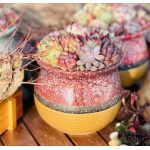Exploring the Fascinating World of Pachyphytum: An Introduction

Introduction to Pachyphytum:
Pachyphytum is a genus of succulent plants native to Mexico and Central America, belonging to the Crassulaceae family. These charming plants are treasured by succulent enthusiasts for their unique appearance, ease of care, and diverse range of species and cultivars. With their rosette-shaped leaves, striking colors, and compact growth habits, Pachyphytums add beauty and interest to any collection or garden.
Distinctive Features and Growth Habits:
Pachyphytum plants are characterized by their thick, fleshy leaves and compact, clustering growth habits. The leaves often have a powdery or waxy coating, which helps reduce water loss and gives them a distinctive blue-gray, purple, or green hue. Some species produce offsets or "pups" at the base of the plant, creating attractive clusters over time.
Habitats and Distribution:
Pachyphytums are primarily found in the mountainous regions of Mexico and Central America, where they inhabit rocky slopes, cliffsides, and canyons. They are adapted to thrive in arid environments with well-draining soil and plenty of sunlight. While they are naturally occurring in these regions, Pachyphytums have also become popular as ornamental plants in gardens, containers, and indoor collections worldwide.
Cultural Significance and Symbolism:
In Mexican folklore, Pachyphytum plants are sometimes associated with protection, luck, and prosperity. They are often included in traditional gardens and landscapes as symbols of resilience and endurance. Additionally, some indigenous cultures in Mexico and Central America have utilized Pachyphytum species for medicinal purposes, treating ailments ranging from digestive issues to skin conditions.
Growing Conditions and Care:
Pachyphytums are relatively low-maintenance plants that thrive in bright, indirect light and well-draining soil. They prefer temperatures between 60°F to 80°F (15°C to 27°C) and should be protected from frost and extreme heat. Watering should be done sparingly, allowing the soil to dry out completely between waterings to prevent root rot. Pachyphytums are also susceptible to overwatering, so it's essential to err on the side of underwatering rather than overwatering.
Propagation and Repotting:
Pachyphytums can be easily propagated from leaf cuttings or offsets. Leaf cuttings should be allowed to callus over before being placed in a well-draining potting mix, where they will develop roots and eventually grow into new plants. Offsets can be gently removed from the parent plant and planted in their own containers. Repotting is typically only necessary when the plant outgrows its container or when the soil becomes compacted.
Conclusion:
Pachyphytum plants are captivating succulents with a rich diversity of forms, colors, and growth habits. Whether grown as ornamental specimens or cherished for their cultural significance, Pachyphytums continue to enchant and inspire people around the world. By providing the right growing conditions and a little care, you can enjoy the beauty and benefits of Pachyphytum plants in your own home or garden.
- Hits: 44




